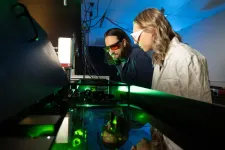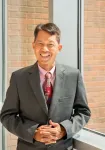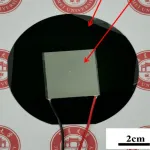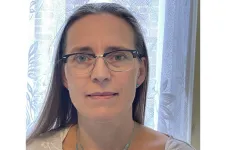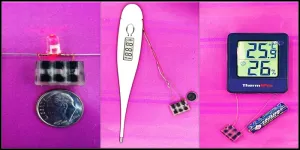(Press-News.org) Solar power technologies, which use solar cells to convert sunlight to electricity or storable fuels, are gaining momentum in a world looking beyond fossil fuels for its energy needs.
The dark bluish solar panels that dot rooftops and open fields today are typically made from silicon, a well-tested semiconductor material. Silicon photovoltaic technology has its limitations, though, losing up to 40% of the energy it collects from sunlight in the form of heat waste. Researchers at Colorado State University are studying radical new ways to improve solar power and provide more options for the industry to explore.
CSU chemists are proposing to make solar cells using not silicon, but an abundantly available natural material called molybdenum disulfide. Using a creative combination of photoelectrochemical and spectroscopic techniques, the researchers conducted a series of experiments showing that extremely thin films of molybdenum disulfide display unprecedented charge carrier properties that could someday drastically improve solar technologies.
The experiments were led by chemistry Ph.D. student Rachelle Austin and postdoctoral researcher Yusef Farah. Austin works jointly in the labs of Justin Sambur, associate professor in the Department of Chemistry, and Amber Krummel, associate professor in the same department. Farah is a former Ph.D. student in Krummel’s lab. Their work is published in Proceedings of the National Academy of Sciences.
The collaboration brought together Sambur’s expertise in solar energy conversion using nanoscale materials, and Krummel’s expertise in ultrafast laser spectroscopy, for understanding how different materials are structured and how they behave. Sambur’s lab had become interested in molybdenum sulfide as a possible alternative solar material based on preliminary data on its light absorption capabilities even when only three atoms thick, explained Austin.
That’s when they turned to Krummel, whose lab contains a state-of-the-art ultrafast pump-probe transient absorption spectrometer that can very precisely measure the sequential energy states of individual electrons as they are excited with a laser pulse. Experiments using this special instrument can provide snapshots of how charges flow in a system. Austin created a photoelectrochemical cell using a single atomic layer of molybdenum sulfide, and she and Farah used the pump-probe laser to track the cooling of electrons as they moved through the material.
What they found was astoundingly efficient light-to-energy conversion. More importantly, the laser spectroscopy experiments enabled them to show why this efficient conversion was possible.
They found that the material was so good at converting light to energy because its crystal structure allows it to extract and exploit the energy of so-called hot carriers, which are highly energetic electrons that are briefly excited from their ground states when hit with enough visible light. Austin and Farah found that in their photoelectrochemical cell, the energy from these hot carriers was immediately converted into photocurrent, rather than lost as heat. This hot carrier extraction phenomenon is not present in conventional silicon solar cells.
“This work paves the way for knowing how to design reactors that contain these nanoscale materials for efficient and large-scale hydrogen production,” Sambur said.
The project was a collaboration with Professor Andrés Montoya-Castillo and Dr. Thomas Sayer of University of Colorado Boulder, who contributed theoretical chemistry and computational modeling to help explain and verify the experimental data.
“The discovery required a ‘team science’ approach that brought together many different types of expertise, in computational, analytical and physical chemistry,” Krummel said.
The results give scientists and engineers an avenue of inquiry to explore new approaches to tomorrow’s solar energy technologies. The work was supported by the U.S. Department of Energy, Office of Basic Energy Sciences.
END
Chemists propose ultrathin material for doubling solar cell efficiency
CSU chemists are proposing to make solar cells using not silicon, but an abundantly available natural material called molybdenum disulfide
2023-04-18
ELSE PRESS RELEASES FROM THIS DATE:
A new blueprint calls for reinvigorated global governance
2023-04-18
A Breakthrough for People and Planet: Effective and Inclusive Global Governance for Today and the Future, produced by the independent High-Level Advisory Board on Effective Multilateralism (HLAB), includes comprehensive and detailed recommendations to strengthen the global architecture for peace, security and finance, deliver just transitions for climate and digitalisation, and ensure more equity and fairness in global decision-making. It also argues that gender equality needs to be at the heart of a reinvigorated multilateral architecture along with recommendations to ensure the multilateral system is more networked, more inclusive and more effective.
Six transformational ...
Sugary drink tax improves health, lowers health care costs
2023-04-18
Oakland residents have bought fewer sugary beverages since a local “soda tax” went into effect, and that is likely improving their health and saving the city money, a new UC San Francisco study found.
According to the study publishing April 18 in PLOS Medicine, purchases of sugar-sweetened beverages (SSBs) dropped 26.8% – compared to similar cities not subject to a tax – between July 2017, when the one-cent-per-ounce tax went into effect, and Dec. 31, 2019.
The research comes a little ...
WVU transportation center will bring mobility to rural areas, opening access to country roads
2023-04-18
The upcoming launch of the SMARTER center in the West Virginia University Benjamin M. Statler College of Engineering and Mineral Resources will direct $1.5 million in federal funding toward the development of mobility solutions for transportation challenges faced by rural residents.
Beginning this summer, West Virginia’s SMARTER center — standing for Sustainable Mobility and Accessibility Regional Transportation Equity Research — will position the state to begin taking advantage of cutting-edge technologies like self-driving cars within the next decade, according to lead researcher and assistant ...
Do prescription opioids impact cognitive function in older adults?
2023-04-18
ROCHESTER, Minn. — Prescription opioid use could have a negative effect on cognitive function in older adults, according to a recent Mayo Clinic study published in the Journal of the American Geriatrics Society. The population-based observational study used data from the Mayo Clinic Study of Aging, a research initiative examining the cognitive decline in older people for nearly 20 years.
Findings
The study found that 70% of participants received at least one opioid prescription over an ...
Physics professor receives best paper award
2023-04-18
Wei Chen, professor of physics at The University of Texas at Arlington, is co-author of an article that has received a prestigious best paper award from Bioactive Materials, an international, peer-reviewed research publication.
His study, titled “Nitrogen-doped fluorescence carbon dots as multi-mechanism detection for iodide and curcumin in biological and food samples,” is about the development of nitrogen-doped fluorescent carbon dots as a detection mechanism for iodine and curcumin in food.
The Bioactive Materials best paper award is fully merit-based and is given to researchers who publish articles that make significant ...
New passive device continuously generates electricity during the day or night
2023-04-18
WASHINGTON — Researchers have developed a new thermoelectric generator (TEG) that can continuously generate electricity using heat from the sun and a radiative element that releases heat into the air. Because it works during the day or night and in cloudy conditions, the new self-powered TEG could provide a reliable power source for small electronic devices such as outdoor sensors.
“Traditional power sources like batteries are limited in capacity and require regular replacement or recharging, which can be inconvenient and unsustainable,” said research team leader Jing Liu from Jimei University in China. “Our new TEG design could offer a ...
Casino Guru calls on City, University of London expertise to research and recommend best-practice for self-exclusion standards
2023-04-18
Casino Guru, a global gambling authority with the most extensive database of online casinos, is partnering with City, University of London, to identify best practice in online gambling self-exclusion and to recommend a set of standards for adoption across different jurisdictions.
The origins of the project can be traced back to Casino Guru's Global Self-Exclusion Initiative, launched back in 2020, whose aim is to establish an online self-exclusion scheme on a global scale that would ...
Next decade decisive for PV growth on the path to 2050
2023-04-18
Global experts on solar power strongly urge a commitment to the continued growth of photovoltaic (PV) manufacturing and deployment to power the planet, arguing that lowballing projections for PV growth while waiting for a consensus on other energy pathways or the emergence of technological last-minute miracles “is no longer an option.”
The consensus reached by participants in the 3rd Terawatt Workshop last year follows increasingly large projections from multiple groups around the world on the need for large-scale PV to drive electrification and greenhouse gas reduction. The increasing acceptance of PV ...
AACR: Early trial results show benefits of FGFR inhibitors and PARP/ATR inhibitor combinations in multiple tumor types
2023-04-18
ABSTRACTS: CT016, CT018
ORLANDO, Fla. ― Researchers from The University of Texas MD Anderson Cancer Center presented promising findings from multiple clinical trials today at the American Association for Cancer Research (AACR) Annual Meeting 2023. The studies, which describe results from a novel FGFR inhibitor and from new PARP/ATR inhibitor combinations, were featured in a plenary session highlighting novel biomarker-driven molecularly targeted therapy trials. Information on all MD Anderson AACR Annual Meeting content can be found at MDAnderson.org/AACR.
Basket trial results suggest wider population may benefit from FGFR inhibitor pemigatinib ...
Tiny biobattery with 100-year shelf life runs on bacteria
2023-04-18
BINGHAMTON, N.Y. -- A tiny biobattery that could still work after 100 years has been developed by researchers at Binghamton University, State University of New York.
Last fall, Binghamton University Professor Seokheun “Sean” Choi and his Bioelectronics and Microsystems Laboratory published their research into an ingestible biobattery activated by the Ph factor of the human intestine.
Now, he and PhD student Maryam Rezaie have taken what they learned and incorporated it into new ideas for use outside the body.
A new study in the journal Small, which covers nanotechnology, shares the results from using spore-forming bacteria similar ...
LAST 30 PRESS RELEASES:
Sleeping in on weekends may help boost teens’ mental health
Study: Teens use cellphones for an hour a day at school
After more than two years of war, Palestinian children are hungry, denied education and “like the living dead”
The untold story of life with Prader-Willi syndrome - according to the siblings who live it
How the parasite that ‘gave up sex’ found more hosts – and why its victory won’t last
When is it time to jump? The boiling frog problem of AI use in physics education
Twitter data reveals partisan divide in understanding why pollen season's getting worse
AI is quick but risky for updating old software
Revolutionizing biosecurity: new multi-omics framework to transform invasive species management
From ancient herb to modern medicine: new review unveils the multi-targeted healing potential of Borago officinalis
Building a global scientific community: Biological Diversity Journal announces dual recruitment of Editorial Board and Youth Editorial Board members
Microbes that break down antibiotics help protect ecosystems under drug pollution
Smart biochar that remembers pollutants offers a new way to clean water and recycle biomass
Rice genes matter more than domestication in shaping plant microbiomes
Ticking time bomb: Some farmers report as many as 70 tick encounters over a 6-month period
Turning garden and crop waste into plastics
Scientists discover ‘platypus galaxies’ in the early universe
Seeing thyroid cancer in a new light: when AI meets label-free imaging in the operating room
Neutrophil-to-lymphocyte ratio may aid risk stratification in depressive disorder
2026 Seismological Society of America Annual Meeting
AI-powered ECG analysis offers promising path for early detection of chronic obstructive pulmonary disease, says Mount Sinai researchers
GIMM uncovers flaws in lab-grown heart cells and paves the way for improved treatments
Cracking the evolutionary code of sleep
Medications could help the aging brain cope with surgery, memory impairment
Back pain linked to worse sleep years later in men over 65, according to study
CDC urges ‘shared decision-making’ on some childhood vaccines; many unclear about what that means
New research finds that an ‘equal treatment’ approach to economic opportunity advertising can backfire
Researchers create shape-shifting, self-navigating microparticles
Science army mobilizes to map US soil microbiome
Researchers develop new tools to turn grain crops into biosensors
[Press-News.org] Chemists propose ultrathin material for doubling solar cell efficiencyCSU chemists are proposing to make solar cells using not silicon, but an abundantly available natural material called molybdenum disulfide
